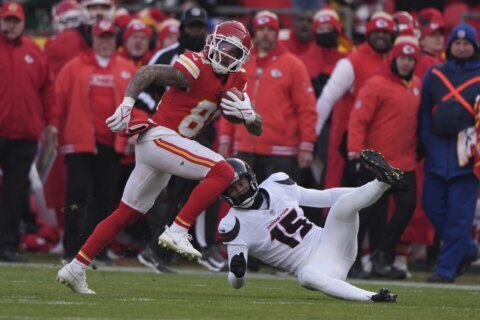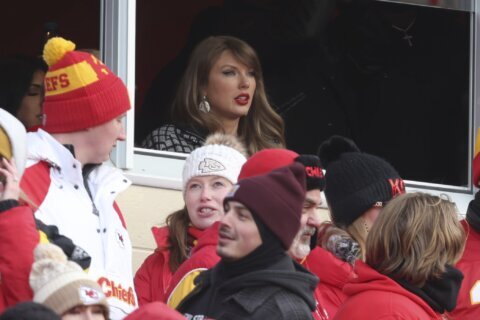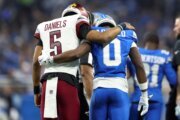On Football analyzes the biggest topics in the NFL from week to week. For more On Football analysis, head here.
___
Paying running backs paid off in Week 1 for teams across the NFL.
Saquon Barkley, Joe Mixon and J.K. Dobbins proved for one game they were worth the investment after changing uniforms in the offseason. So did Josh Jacobs, Aaron Jones and Tony Pollard.
Barkley received a $37.5 million, three-year contract with $26 million guaranteed from the Eagles. He delivered a three-touchdown performance with 109 yards rushing in Philadelphia’s 34-29 win over Green Bay in Brazil.
“He did an excellent job,” Eagles offensive coordinator Kellen Moore said. “He’s a guy who, once he gets out in space, he can make some really big-time plays. So we’re excited.”
Mixon, who got a $25.5 million, three-year deal from Houston after he was traded by Cincinnati, had 159 yards rushing and one score in the Texans’ 29-27 win at Indianapolis.
Dobbins had 130 yards rushing and one TD on just 10 carries for the Los Angeles Chargers in a 22-10 victory over the Raiders. He received a one-year, $1.6 million prove-it deal after injuries limited him in Baltimore the past two seasons.
Aaron Jones had 94 yards rushing and one touchdown for Minnesota in a 28-6 win over the Giants. He got essentially a one-year deal for $7 million after the Packers signed Josh Jacobs to replace him.
Jacobs ran for 84 yards on 16 carries in his debut with Green Bay. The Packers gave him a four-year, $48 million contract with $12.5 million guaranteed.
Tony Pollard had 82 yards rushing and one touchdown in his first game for Tennessee, a 24-17 loss to Chicago. He received a three-year, $21.75 contract with $10.5 million guaranteed.
Overall, seven running backs who previously went to Pro Bowls changed teams in the offseason. Derrick Henry and D’Andre Swift were the other two.
A year ago, many backs felt the position was devalued. They were frustrated about the diminishing contracts and questioned whether teams were committed to them.
They fared much better over the past offseason, though they still are making a fraction of the money going to quarterbacks and wide receivers.
Christian McCaffrey got an extension from San Francisco after earning AP Offensive Player of the Year honors that raised his average annual salary to $19 million, highest among running backs.
Meanwhile, 23 receivers are averaging at least $20 million per season, including six making $30 million.
There are 20 quarterbacks earning an average annual salary of $25 million with 16 making at least $40 million and nine in the $50 million club led by Dak Prescott becoming the first $60 million man with a $240 million, four-year deal.
For one week at least, running backs outshined the QBs. There were more 100-yard rushers (seven) than 300-yard passers (two). Seventeen starting QBs failed to throw for 200 yards in Week 1.
Teams averaged 121.5 yards rushing per game, the best opening week since 2008 when the average was 121.8 yards. The average of 188.3 net yards passing per game was the fewest in any week since Week 15 in 2007.
Many quarterbacks barely played in the preseason, if at all. Lack of action leads to little production. Even though coaches emphasize that joint practice give quarterbacks adequate reps in training camp, it’s not the same. They still wear red jerseys in those practices and don’t have to worry about getting hit.
Quarterbacks need more time to work on their chemistry with receivers and to get in sync with the offensive line. Running backs don’t need as many preseason reps to find an open hole and run with the ball.
Bill Belichick used to say teams use the first two games to figure out their identity. In a way, Week 1 was the fourth preseason game.
“There is nothing more important than game experience,” Rams offensive coordinator Mike LaFleur said Thursday. “Whether guys play in the preseason or not … obviously, you have training camp and the competitive practice whether it be a joint practice (or something else), there is nothing like going in there on Sunday when all the coaches are off to the side and you have 60 minutes, usually about 30 to 35 minutes of offensive ball to see what you’ve learned and how you adapt throughout a game. They have the speed of it down after Week 1. … That Week 1 to Week 2 is usually a big jump for every team.”
Expect to see numbers increase for quarterbacks this week. After all, the NFL is a passing league.
____
AP Pro Football Writers Josh Dubow contributed.
___
AP NFL: https://apnews.com/hub/nfl
Copyright © 2025 The Associated Press. All rights reserved. This material may not be published, broadcast, written or redistributed.







